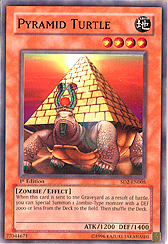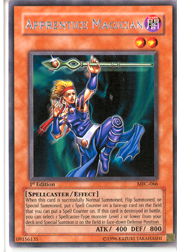In last week’s article, I set out a definition for self-replacing monsters—a monster that, when destroyed, can replace itself from the deck—and discussed their importance in the game. Self-replacing monsters help maintain your field presence while searching out specific monsters. This gives you a resilient field and provides access to the monsters that are still lurking in your deck. The result? Reliability!
Last week I focused on the self-replacing monsters from Magic Ruler, where the mechanic first appeared. Today, I’ll turn my attention to the self-replacing monsters released after Magic Ruler. The Magic Ruler group of monsters adhered to a consistent format (each monster was aligned with an attribute; each could only search out monsters matching that attribute with 1500 ATK or less; each had 1400 ATK; and each were level 4) but this second group is very diverse. The options that each one presents can be valuable to many decks, including a few that are currently very popular. If you’re still relatively new to the game, you might not even be aware of some of these options, so pay close attention and see what might help out your deck.
Are you ready? Let’s get started. I can’t think of a more deserving monster to lead off this category than the mighty Pyramid Turtle!
Pyramid Turtle: Zombie
 Pyramid Turtle comes from the Pharaonic Guardian expansion. It has only1200 ATK, which is significantly less than the 1400 ATK self-replacing monsters from Magic Ruler. It’s all good, though—you want it to be destroyed, because once it’s gone, something wicked this way comes. The search parameter is “a DEF of 2000 or less.” There’s no limit on the monsters’ ATK at all! It seeks out Zombie-type monsters instead of monsters of a set attribute, making it a bit narrow when compared to something like Mystic Tomato, but the monsters it can search out are nothing short of fantastic. Pyramid Turtle is the reason Zombie decks are viable. Here are a few good monsters it can fetch:
Pyramid Turtle comes from the Pharaonic Guardian expansion. It has only1200 ATK, which is significantly less than the 1400 ATK self-replacing monsters from Magic Ruler. It’s all good, though—you want it to be destroyed, because once it’s gone, something wicked this way comes. The search parameter is “a DEF of 2000 or less.” There’s no limit on the monsters’ ATK at all! It seeks out Zombie-type monsters instead of monsters of a set attribute, making it a bit narrow when compared to something like Mystic Tomato, but the monsters it can search out are nothing short of fantastic. Pyramid Turtle is the reason Zombie decks are viable. Here are a few good monsters it can fetch:
Vampire Lord
Patrician of Darkness
Spirit Reaper
Ryu Kokki
Not bad! The original trinity of Zombies was Vampire Lord, Spirit Reaper, and Patrician of Darkness—the ability to have any of those out as early as turn one gave Zombie decks a high degree of control, and also many other options that were unparalleled by other themed archetypes. Patrician is out of style now, though . . . these days, it’s all about Ryu Kokki. Warrior monsters are still quite popular, so most duelists like to add in something to hurt them. Ryu Kokki is also just plain big. 2400 ATK and skip the tribute? Yes, please, can I have some more! Pyramid Turtle can bring out monsters in defense position as well, which also expands your options.
Masked Dragon: Dragon
 People might laugh at ol’ Blue-Eyes, but even though Dragon decks rarely make it to the top tier, plenty of duelists still like to play with them. Troop Dragon once reigned supreme as the maintainer of field presence in Dragon decks, but Masked Dragon has usurped its position with better stats (its 1400 ATK is reminiscent of last week’s group of monsters) and the ability to summon a far wider range of monsters. Here are the highlights:
People might laugh at ol’ Blue-Eyes, but even though Dragon decks rarely make it to the top tier, plenty of duelists still like to play with them. Troop Dragon once reigned supreme as the maintainer of field presence in Dragon decks, but Masked Dragon has usurped its position with better stats (its 1400 ATK is reminiscent of last week’s group of monsters) and the ability to summon a far wider range of monsters. Here are the highlights:
Troop Dragon
Twin-Headed Behemoth
Red-Eyes B. Chick
Different Dimension Dragon
The Dragon Dwelling in the Cave
Masked Dragon can also bring out the less-popular Gray Wing and Spirit Ryu, which sometimes see play in Dragon-based strategies. Dragon decks rely on a variety of huge monsters mixed with smaller support monsters, and Masked Dragon speeds the deck up by thinning it out and giving better access to that support. Masked Dragon makes a perfect wall for those times when Lightning Vortex or Mirror Force takes down all your big attackers and leaves your field open. If you really like self-replacing monsters, or if you just enjoy annoying your opponent, then consider building a deck with UFO Turtle, Masked Dragon, and Troop Dragon. They’ll just keep on hitting the field! Like Pyramid Turtle, Masked Dragon can also bring out defense position monsters, so it’s great to use with The Dragon Dwelling in the Cave.
Howling Insect: Insect
 Howling Insect does the same thing, giving you the option of summoning monsters into face up attack or face up defense position. It also has 1400 ATK and activates in the graveyard, so all those Creature Swap tricks that work so well with most other self-replacing monsters will also work here. Howling Insect searches out other Insects, and while that’s a limited field, there are some neat options:
Howling Insect does the same thing, giving you the option of summoning monsters into face up attack or face up defense position. It also has 1400 ATK and activates in the graveyard, so all those Creature Swap tricks that work so well with most other self-replacing monsters will also work here. Howling Insect searches out other Insects, and while that’s a limited field, there are some neat options:
Flying Kamakiri #1
Pinch Hopper
Ultimate Insect LV3
Pinch Hopper is the best of these, giving you fast access to this tiny powerhouse in defense position. An opponent will almost have to attack it if he or she wants to press an offensive, and when that happens, you can drop something huge like Ultimate Insect LV7. Talk about a Swarm of Locusts. Increasing access to Pinch Hopper and Ultimate Insect LV3, Howling Insect is a must for Ultimate Insect decks. Flying Kamakiri #1 is itself a self-replacing monster, so there are some interesting combinations possible there as well.
Apprentice Magician: Spellcaster
 If we’re going to award a medal for “Best Monster in Group,” Apprentice Magician is probably competing directly with Pyramid Turtle. It’s been seen in many decks since last year’s World Championships, where several top-ranked duelists demonstrated its effectiveness, and its popularity will definitely continue to grow. It’s a Dark monster, so it contributes to Chaos summons, and it can be brought out with Mystic Tomato. For these reasons, Apprentice Magician has gained a huge amount of utility since the format changed in April. The reason? The rotation of Delinquent Duo and Graceful Charity back into the format has made Magician of Faith a game-winning card, and reusing either of the three “Trinity” cards in a single game can often give a skilled duelist enough leverage to win. This has made Apprentice Magician one of the most feared opening moves in the game, and that’s just one of the monsters it can summon! If you’re out of copies of Magician of Faith, you can still get your hands on:
If we’re going to award a medal for “Best Monster in Group,” Apprentice Magician is probably competing directly with Pyramid Turtle. It’s been seen in many decks since last year’s World Championships, where several top-ranked duelists demonstrated its effectiveness, and its popularity will definitely continue to grow. It’s a Dark monster, so it contributes to Chaos summons, and it can be brought out with Mystic Tomato. For these reasons, Apprentice Magician has gained a huge amount of utility since the format changed in April. The reason? The rotation of Delinquent Duo and Graceful Charity back into the format has made Magician of Faith a game-winning card, and reusing either of the three “Trinity” cards in a single game can often give a skilled duelist enough leverage to win. This has made Apprentice Magician one of the most feared opening moves in the game, and that’s just one of the monsters it can summon! If you’re out of copies of Magician of Faith, you can still get your hands on:
Time Wizard
Hand of Nephthys
Old Vindictive Magician
A pair of Apprentice Magician can enable you to run a single copy of Hand of Nephthys. Add in one Sacred Phoenix of Nephthys, and you’ve got full Phoenix support with just two cards. Most decks can afford that, and most can benefit from it. Old Vindictive Magician can be a bit difficult due to its similarity to the more-versatile Night Assailant, but searchability is an attractive inducement to include it instead. And Time Wizard? Sure, Time Wizard was a favorite of small duelists with theme decks back in the day, and I’ll grant you his effect is a coin toss—and a very risky one at that. However, a single copy can be game-winning even without flip-manipulation like Second Coin Toss. And it’s much more humiliating for your opponent than Lightning Vortex could ever be.
Beyond the above-listed self-replacing monsters, there are some other, more limited monsters that can only summon more copies of themselves: Giant Germ, Nimble Momonga, Hyena, and Troop Dragon. While these monsters don’t offer the wide range of search capabilities that other self-replacing monsters do, they still maintain board presence and are superb opening plays. Nimble Momonga and Giant Germ are particularly annoying due to their additional effects.
Now that you’ve got a better understanding of what these cards are and how they work, go and look over your decks. It’s likely that there’s at least one self-replacing monster that can make your deck more competitive. If you’ve played at all, you know that duels can often come down to luck, and the flexibility that these cards add to a deck can help eliminate a lot of the chance involved in high-level Yu-Gi-Oh! competition. Consider the options that self-replacing monsters add to a deck, and use them wisely. They’ll serve you well by reducing risks, creating overwhelming numbers, and giving you more choices—and that can often be exactly what you need to win.